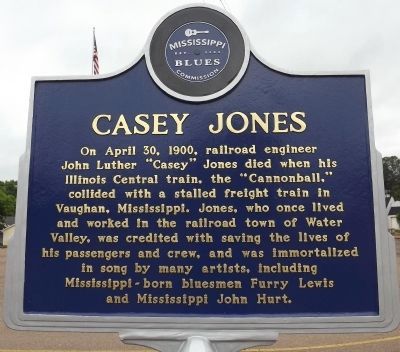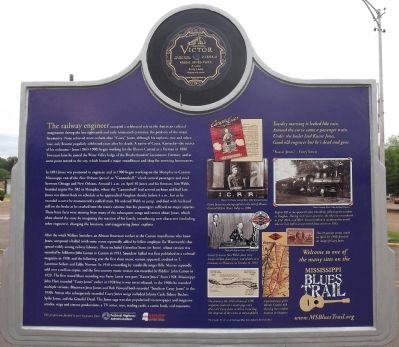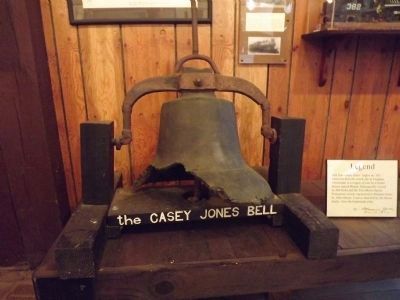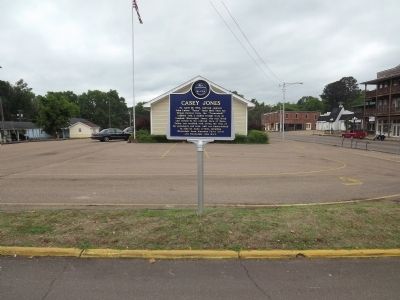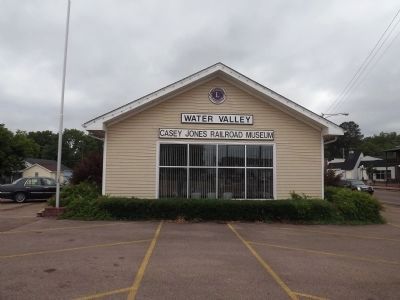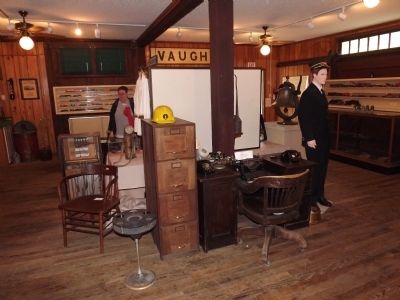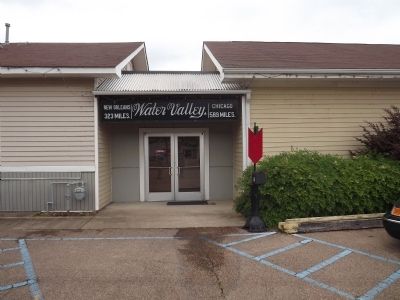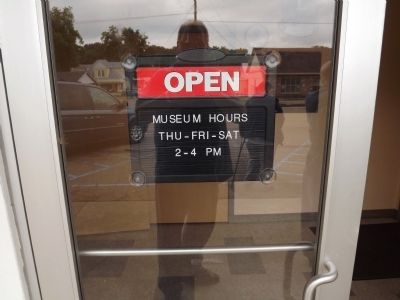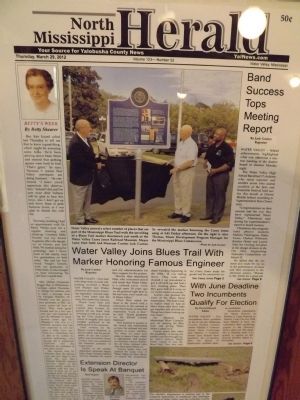Casey Jones
(Front)
On April 30, 1900, railroad engineer John Luther "Casey" Jones died when his Illinois Central train, the "Cannonball," collided with a stalled freight train in Vaughan, Mississippi. Jones, who once lived and worked in the railroad town of Water Valley, was credited with saving the lives of his passengers and crew, and was immortalized in song by many artists, including Mississippi-born bluesman Furry Lewis and Mississippi John Hurt.
(Backside)
The railway engineer occupied a celebrated role in the American cultural imagination during the late eighteenth and early nineteenth centuries, the peak era of the steam locomotive. None achieved more acclaim than "Casey" Jones, although his exploits, true and otherwise, only became popularly celebrated years after his death. A native of Cayce, Kentucky-the source of his nickname-Jones (1863 - 1900) began working for the Illinois Central as a fireman in 1888. Two years later he joined the Water Valley Lodge of the Brotherhood of Locomotive Fireman, and at some point moved to the city, which housed a major roundhouse and shop for servicing locomotives.
In 1891 Jones was promoted to engineer, and in 1900 began working on the Memphis to Canton, Mississippi, run of the New Orleans special or "Cannonball," which carried passengers and mail between Chicago and
New Orleans. Around 1 a.m. on April 30 Jones and his fireman, Sim Webb, boarded engine No. 382 in Memphis, where the "Cannonball" had arrived an hour and half late. Jones was almost back on schedule as he approached Vaughan shortly before 4 a.m., but as he rounded a curve he encountered a stalled train. He ordered Webb to jump, and died with his hand still on the brake as he crashed into the train's caboose, but his passengers suffered no major injuries. These basic facts were missing from many of the subsequent songs and stories about Jones, which often altered the story by imagining the reaction of his family, introducing new characters (including other engineers), changing the locations, and exaggerating Jones' exploits.After the wreck Wallace Saunders, an African American worker at the Canton roundhouse who knew Jones, composed a ballad (with some verses reportedly added by fellow employee Ike Wentworth) that spread widely among railroad laborers. These included Cornelius Steen (or Stein), whose version was recorded by folklorist John Lomax in Canton in 1933. Saunders' ballad was first published in a railroad magazine in 1908, and the following year the first sheet music version appeared, credited to T. Lawrence Seibert and Eddie Newton. In 1910 a recording by vaudeville singer Billy Murray reputedly sold over a million copies, and the first country music version was
recorded by Fiddlin' John Carson in 1923. The first issued blues recording was Furry Lewis' two-part "Kassie Jones" from 1928. Mississippi John Hurt recorded "Casey Jones" earlier in 1928 but it was never released; in the 1960's he recorded multiple versions. Bluesman Jesse James and Bob Howard both recorded "Southern Casey Jones" in the 1930s. Artists who subsequently recorded Casey Jones songs included Johnny Cash, Sidney Bechet, Spike Jones, and the Grateful Dead. The Jones saga was also popularized via newspaper and magazine articles, stage and cinema productions, a TV series, toys, trading cards, a comic book, and museums.Erected 2012 by Mississippi Blues Commission. (Marker Number 151.)
Topics and series. This historical marker is listed in these topic lists: African Americans • Arts, Letters, Music • Entertainment • Railroads & Streetcars. In addition, it is included in the Mississippi Blues Trail series list. A significant historical month for this entry is April 1879.
Location. 34° 9.021′ N, 89° 37.923′ W. Marker is in Water Valley, Mississippi, in Yalobusha County. Marker is on Blackmur Street (State Highway 315) 0.1 miles Main Street (State Highway 315), on the right when traveling east. Touch for map. Marker is at or near this postal address: 105 Railroad Avenue, Water Valley MS 38965, United States of America. Touch for directions.
Other nearby markers. At least 8 other markers are within 12 miles of this marker, measured as the crow flies. James Ford (about 400 feet away, measured in a direct line); Hubert Creekmore (about 500 feet away); Cradle of North Mississippi Methodism (about 800 feet away); Turnage Drugstore (approx. 0.2 miles away); Dallas Jones Crossing (approx. 4.9 miles away); Theora Hamblett (approx. 9.3 miles away); Mississippi Central R.R. Campaign (approx. 10.7 miles away); Battle of Coffeeville (approx. 11.7 miles away). Touch for a list and map of all markers in Water Valley.
Credits. This page was last revised on June 16, 2016. It was originally submitted on May 23, 2012, by Ken Smith of Milan, Tennessee. This page has been viewed 1,323 times since then and 82 times this year. Last updated on May 25, 2012, by Ken Smith of Milan, Tennessee. Photos: 1, 2, 3, 4, 5, 6, 7, 8, 9. submitted on May 23, 2012, by Ken Smith of Milan, Tennessee. • Craig Swain was the editor who published this page.
